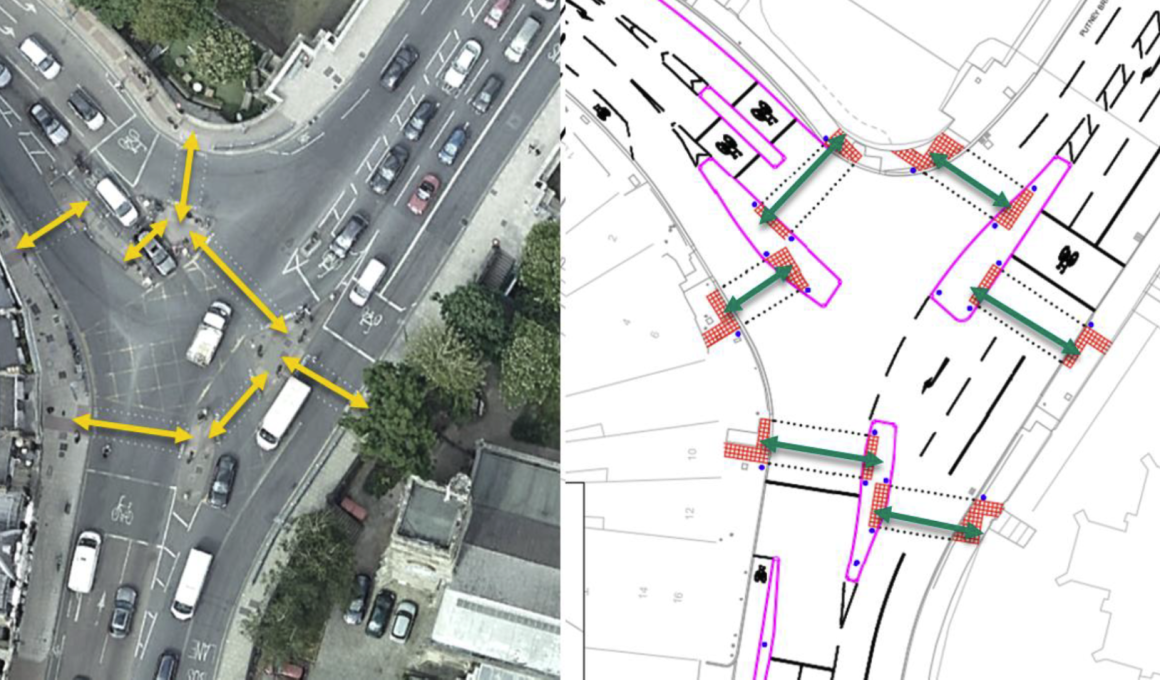Wandsworth Council has acknowledged that traffic signals at the redesigned Putney Bridge junction were implemented with different timings than originally modelled and approved by Transport for London, according to a report going to councillors next week.
The report [pdf] to the Transport Overview and Scrutiny Committee on 20 November reveals the £835,000 junction redesign, completed in December 2024, has required an additional £169,000 in emergency fixes, bringing the total cost to just over £1 million.
It is signed by Director of Growth and Place Nick O’Donnell and includes a formal apology and presents findings from an independent review by consultancy AECOM that was commissioned after unexpected congestion emerged on Lower Richmond Road and Putney Bridge Road.
The findings come after hundreds of residents packed St Margaret’s Church last month to confront Council Leader Simon Hogg about gridlock that has left elderly people in tears and created dangerous conditions on residential streets. Hogg promised them this report would contain “expert advice” on what went wrong.
Signal timing mismatch
AECOM’s post-implementation review [pdf], based on traffic surveys conducted in June 2025, found that “signal timings have not been implemented as modelled by AECOM and approved by TfL.”
During morning peak hours, Lower Richmond Road’s left turn lost 10 seconds of green time compared to the approved model, while the right turn lost 4 seconds. Putney Bridge Road lost 21 seconds in the morning peak and 12 seconds in the evening peak.
By contrast, the main north-south corridor along Putney High Street and Putney Bridge gained green time: between 8 and 20 seconds depending on time of day and direction.
The report states that Lower Richmond Road “has experienced a significant reduction in available green time, particularly for the left turn towards Putney Bridge (a reduction of around 50%).”
When AECOM input the actual signal timings into their original 2021 model, it “closely replicate[d] the queues observed on site,” according to the report, suggesting the modelling was accurate but the implementation differed from the plan.

Lower traffic than 2018, but worse congestion
The report presents an unexpected finding: traffic volumes crossing Putney Bridge are now lower than before Hammersmith Bridge closed in April 2019.
Department for Transport data analysed by the council shows that in 2024, some 37,313 vehicles crossed the bridge daily compared to 42,498 in 2018: a reduction of over 5,000 vehicles per day despite Hammersmith Bridge remaining closed.
The junction redesign had been based on a 2021 modelling assumption that Hammersmith Bridge would reopen by 2026. The report notes this explicitly: “The standard London wide assumption for all modelling work at the time (2021) was that Hammersmith Bridge would be open in 2026.”
Yet even with fewer vehicles than anticipated, congestion has worsened significantly on specific approaches to the junction.
The report includes collision data showing that serious injuries at the junction doubled in the five years before the redesign, rising from two between 2014-2018 to four between 2020-2024.
The original scheme was developed partly in response to 23 collisions recorded between 2014 and 2018, when “footways were narrow, and it was difficult for pedestrians to cross and cyclists were unprotected from traffic.”
Pedestrian and cyclist increases
The review found significant increases in both pedestrian and cyclist numbers since 2021, particularly during peak hours.
The report notes there has been “a significant increase in the total number of pedestrians crossing the junction since 2021,” especially during morning peak over Putney High Street and Putney Bridge, and during evening peak over Putney High Street and Lower Richmond Road.
Pedestrians crossing on red signals have reduced “significantly,” which the report states “will contribute to road safety” and can be attributed to “larger refuge islands for pedestrian comfort, shorter waiting time and journey times for pedestrians.”
The number of cyclists using the junction has also increased compared with 2021, which the report describes as “consistent with the increase in cycling in London overall in the last few years” and “a positive indication that the new layouts are effective in supporting modal shift.”
However, the report notes that usage of a newly introduced left turn for cyclists from Putney Bridge Road onto Putney High Street has been “relatively modest,” with some cyclists preferring to use “the adjacent footway and potentially the pedestrian crossing” instead. The council now plans to suspend this feature as it has “reduced green time for vehicles turning from Putney Bridge Road onto the High Street.”
Changes implemented and planned
Since August 2025, the council has implemented numerous changes following approval from TfL, including:
- Two lanes installed on Lower Richmond Road approach (August)
- Motorcycles permitted in bus lanes on Putney Bridge (October)
- Amended signal timings to create extra space on Putney High Street (early October)
- Additional green time for vehicles turning from Putney Bridge Road to Putney High Street (early October)
- Additional green time for vehicles turning left from Lower Richmond Road onto Putney Bridge (early October)
- Trial relocation of bus stop P outside Kenilworth Court on Lower Richmond Road (late October)
- New configuration providing more green time for both Lower Richmond Road and Putney Bridge Road (late October)
Further changes expected by February 2026 include:
- Trial suspension of southbound bus lane outside Odeon Cinema (November)
- Double yellow lines on Putney High Street, Lower Richmond Road and Putney Bridge Road (November)
- Lane reassignment on Putney High Street outside Putney Station (December)
- Improved space for vehicles to pass stationary buses outside TK Maxx (January)
- Suspension of the cyclists’ left turn from Putney Bridge Road onto Putney High Street (February)
The report states that “further optioneering work is also underway covering a broad range of wider layout changes,” though implementation will depend on modelling outcomes and TfL approval.
Why not revert to the old layout?
The report includes a dedicated section addressing calls to “reinstate the old junction layout at Putney Bridge.”
The council’s position is that “the reintroduction of the old junction layout at Putney Bridge is not an option, because the old layout would not pass current design standards and safety requirements as set out by TfL.”
The report states that the previous layout “suffered lots of pedestrian crowding and congestion” on small pedestrian islands, and “putting back smaller pedestrian islands again would increase road danger.”
It cites TfL’s streetscape design guide, which “requires a minimum pedestrian island width of 2.5m and an offset of 4m between staggered crossings,” noting that “the pre-2024 layout did not achieve this.”
The old layout also required a three-stage crossing compared to the current two-stage design, the report adds.
Regarding Lower Richmond Road, the report argues that the old layout’s two approach lanes were “really equivalent to 1.2 lanes at best” because vehicles had to merge into Putney Bridge’s single northbound lane. “It is also worth noting when a large vehicle was at the stop line, this would have prevented two vehicles turning left at the same time.”
Public consultation responses
The report reveals a stark disparity in consultation responses [pdf]. The Putney Action Group’s survey in July-August received 1,373 responses that were “highly critical of the junction changes,” while the council’s own survey conducted by AECOM in October gathered feedback from 78 in-person respondents.
The report notes that the council survey “was not intended for online distribution and sharing, as it was aimed at gathering views of those observed using the junction.” However, a QR code given to some participants “was widely circulated online,” with 912 additional online responses received after 9 October.
The report distinguishes between the two response types, stating that the 78 in-person respondents “reported positive experiences overall, especially in relation to pedestrian and cyclist safety,” while online respondents “expressed markedly more negative views” focused on “increased traffic congestion, longer travel times, and perceived deterioration in air quality.”
Written submissions from Wandsworth Cycling Campaign provided positive feedback, referring to “significant improvement due to 2024 changes.” Wandsworth Living Streets also submitted positive feedback regarding cycle segregation, increased bus lane hours, and improved pavements.
Side streets and wider factors
The report acknowledges resident concerns about congestion on side roads but notes that traffic surveys conducted on roads off Putney High Street found “hourly traffic volumes remain below the council’s traffic management intervention level of 300 vehicles at peak hour.”
Additional surveys were conducted in October on roads off Putney Bridge Road and Lower Richmond Road, with data still being analysed.
The report identifies other factors contributing to congestion beyond the junction changes, including Hammersmith Bridge’s ongoing closure, Clean Air Neighbourhood schemes in Hammersmith and Fulham that restrict through-traffic near Wandsworth Bridge, and “various road and street works in and outside of the borough.”
The council states it “fully supports the reopening of Hammersmith Bridge and continues to lobby” for investment in the bridge’s repair.
Background
The junction redesign was the final element of the Putney High Street Improvement Project, which began in 2017 at the request of local councillors and included public realm improvements, pavement widening, new cycle infrastructure, and tree planting between 2019 and 2024.
The final junction design was presented to the council’s Transport Committee in September 2023 (Paper 23-304) and received unanimous support from committee members before being agreed by the Council’s Executive on 25 September 2023.
Physical works on the junction were completed in early December 2024.
The Transport Overview and Scrutiny Committee meets on Wednesday 20 November to review the report.
Read our analysis: A junction designed for cyclists in a town that drives










